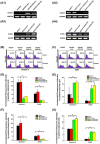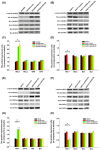Overexpression of CHI3L1 is associated with chemoresistance and poor outcome of epithelial ovarian carcinoma
- PMID: 26452028
- PMCID: PMC4741859
- DOI: 10.18632/oncotarget.5469
Overexpression of CHI3L1 is associated with chemoresistance and poor outcome of epithelial ovarian carcinoma
Abstract
We propose CHI3L1 as a prognostic biomarker for patients with epithelial ovarian carcinoma (EOC) and also suggest possible biological functions of CHI3L1. We measured CHI3L1 expression with quantitative real time-polymerase chain reaction (qRT-PCR) in 180 women with EOC and evaluated correlations between CHI3L1 expression, clinicopathological characteristics, and the outcomes of the patients. The expression of CHI3L1 was higher in cancerous tissues than in normal tissues. The expression of CHI3L1 was also higher in patients with a serous histological type, advanced stage, and chemoresistance. Patients with high CHI3L1 expression had a shorter progression-free survival (p < 0.001)and overall survival (p < 0.001). Patients with high CHI3L1 expression also had a high risk of recurrence (p < 0.001)and death (p < 0.001). In vitro studies showed that CHI3L1 up-regulated the expression of anti-apoptotic Mcl-1 protein and hampered paclitaxel-induced apoptosis of ovarian cancer cells. These results suggest that CHI3L1 shows potential as a prognostic biomarker for EOC. CHI3L1 may promote chemoresistance via inhibition of drug-induced apoptosis by up-regulating Mcl-1.
Keywords: CHI3L1; apoptosis; chemoresistance; epithelial ovarian carcinoma.
Conflict of interest statement
The authors declare no potential conflict of interest.
Figures




References
-
- Siegel R, Naishadham D, Jemal A. Cancer statistics, 2012. CA Cancer J Clin. 2012;62:10–29. - PubMed
-
- Agarwal R, Kaye SB. Ovarian cancer: strategies for overcoming resistance to chemotherapy. Nat Rev Cancer. 2003;3:502–516. - PubMed
-
- Stuart GC. First-line treatment regimens and the role of consolidation therapy in advanced ovarian cancer. Gynecologic Oncology. 2003;90:S8–15. - PubMed
-
- O'Gorman DM, Cotter TG. Molecular signals in anti-apoptotic survival pathways. Leukemia. 2001;15:21–34. - PubMed
Publication types
MeSH terms
Substances
LinkOut - more resources
Full Text Sources
Other Literature Sources
Medical

